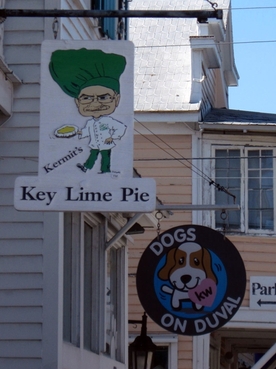
Our visit to Key West included a taste of some Key Lime Pie
As we approach the Ides of March, we are also nearing the end of our stay in Marathon. The seafood festival has come and gone, and we need to work our way back north along Florida’s west coast to Orion Jr’s summer home in LaBelle.
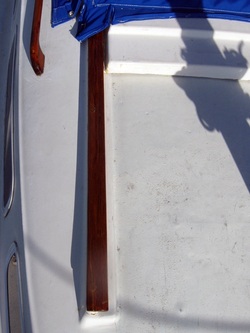
Varnished wood on Orion Jr
Hot Times Ahead
As we prepare to leave Orion Jr in Florida for the hot summer months (assuming Orion back in Hampton doesn’t sell), we started reviewing things that other boaters and experts recommended. On the exterior, the woodwork needed to be given some more protection from the sun, in the form of several more coats of varnish. Cathy took this on, finishing off (for the 3rd time?) Dave’s repair of the split in the starboard guide rail that he had epoxied together. She fit a teak plug and sanded it smooth once in place so the varnish layers could be applied.
As we prepare to leave Orion Jr in Florida for the hot summer months (assuming Orion back in Hampton doesn’t sell), we started reviewing things that other boaters and experts recommended. On the exterior, the woodwork needed to be given some more protection from the sun, in the form of several more coats of varnish. Cathy took this on, finishing off (for the 3rd time?) Dave’s repair of the split in the starboard guide rail that he had epoxied together. She fit a teak plug and sanded it smooth once in place so the varnish layers could be applied.
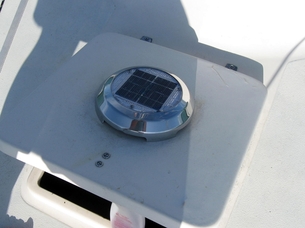
New Stainless Steel Nicro Vent
Another concern with Florida’s heat and humidity was the air circulation down below. To help facilitate the maximum air flow, we decided to replace the Nicro solar vent in the forward hatch cover with a newer stainless steel version. This would have a few benefits over the old model (which still worked). The stainless steel would be stronger against the sun and the abuse of people moving about on deck. The solar-rechargeable battery included would ensure the fan ran 24 hours a day. It also had a sleeve that could be closed in severe weather to prevent water incursion down below and an optional insect screen to keep the bugs away. (When we removed the old fan, Dave discovered that it too had the rechargeable battery, but it was just past its useful life. Since the fan still works, we kept it for some unknown future purpose.) The installation was easy, since we had purchased one with the same footprint as the existing fan. After sealing it in place, we drowned it with water and were reassured when nothing leaked. (It is right above the bed after all.) The literature that came with the vent allowed Dave to calculate its air circulation capacity, which suggested it was about twice the size we needed for the little boat.
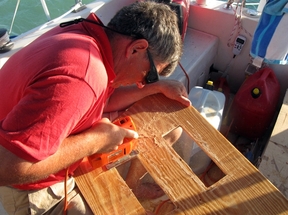
Dave cuts out vent holes in new hatch board
However, having a fan on one end of the boat was not going to be enough to ensure good air flow. We needed another opening to allow it to pull air through the boat. To accomplish this, Dave decided to make a new hatch board that would take the place of the 3 lower boards on the companionway. Borrowing an idea from our Beneteau, he was going to cut 2 openings in the board that would be covered by louvered vents that would allow the air to be drawn in, while protecting them from rain. Cathy would then install screen on the back of the openings to prevent bugs and wasps from entering the boat. Since this was going to be a storage solution only, Dave cut the board out of plywood and with the aid of another cruiser who was a marine carpenter, routed the top to fit the existing boards. Using 2 plastic vents purchased off Amazon, Dave cut their back openings so that they would be no thicker than the board and cut the openings in the board to match. Cathy applied several layers of a Minwax product, Helmsman to the new (and existing) board to protect it. Once the sealing was done, Dave could screw down the vents for a brand-new hatch board, that would allow a lot of air circulation.
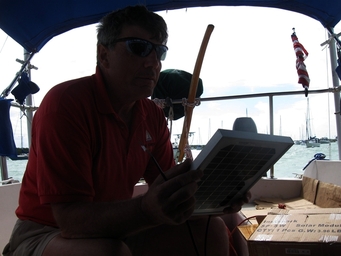
Since we won't have any power hook-ups in our slip at Port LaBelle Marina, we also needed to ensure the batteries stayed topped off. In hot weather, they can lose as much as 3% a week. To provide the charging capacity would not require much solar energy, so Dave found a small 5-watt panel on Amazon which should keep up with the drain. It is small enough to be mounted in the cockpit and can be out of the way.
There will still be plenty more work ahead before we leave the boat, but at least now there are a couple of bigger tasks behind us.
There will still be plenty more work ahead before we leave the boat, but at least now there are a couple of bigger tasks behind us.
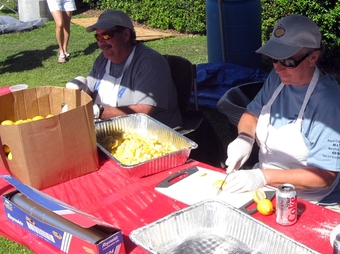
Cathy and Councilman Richard Keating cutting a case of lemons
Seafood and More Seafood
We spent most of the weekend of Marathon’s Seafood Festival in the food tent helping to bread hundreds of pounds of fish and cutting up cases of lemons. In the process we got to know some local fisherman, a city councilman, the mayor and of course some fellow cruisers. All the work was not without its rewards, as we were served enough fried fish, clams, potato chips, smoothies, and Key Lime pie to be pretty full by the time we headed home – tired but having enjoyed ourselves.
It was also a bit of irony that when we introduced ourselves to a fellow worker, he said that he already recognized Dave, since he was a councilmember and Dave had spoken at 2 council meeting so far. The long day gave us time to chat about lots of things, some of which included the concerns of the boaters in the harbor. Richard even recognized our work at the festival after Dave addressed the next council meeting about the rates issues. It’s a small world here in Marathon.
So, What’s all the Noise About Marathon?
Those who read this blog that are fellow cruisers may have heard the furor that’s been raised by the rate changes and anchoring restriction proposals. The good news is that there has been some progress. Dave’s efforts with the local media generated enough interest that an article was written about Captain Jack, a local 90+ year-old boater who has lived on the dock for several years. As the article went to press, he was given a reprieve from the higher rates. Finally, although we won’t be here to participate, the City Manager has agreed to a meeting with boaters at the marina before the end of March to discuss and possibly adjust the rates. So, there is hope on that front.
However, the anchoring restrictions are still an open question. We’ll stay in touch after we leave and we urge those of you who care about this harbor to do the same.
Moving On
So, we’re heading out soon. We’ve topped off the water and fuel tanks, made sure the engine still starts, cleaned the dinghy bottom and filled the icebox and freezer to the brim. If all goes as planned, the next update will find us somewhere north, but likely still in Florida.
Those who read this blog that are fellow cruisers may have heard the furor that’s been raised by the rate changes and anchoring restriction proposals. The good news is that there has been some progress. Dave’s efforts with the local media generated enough interest that an article was written about Captain Jack, a local 90+ year-old boater who has lived on the dock for several years. As the article went to press, he was given a reprieve from the higher rates. Finally, although we won’t be here to participate, the City Manager has agreed to a meeting with boaters at the marina before the end of March to discuss and possibly adjust the rates. So, there is hope on that front.
However, the anchoring restrictions are still an open question. We’ll stay in touch after we leave and we urge those of you who care about this harbor to do the same.
Moving On
So, we’re heading out soon. We’ve topped off the water and fuel tanks, made sure the engine still starts, cleaned the dinghy bottom and filled the icebox and freezer to the brim. If all goes as planned, the next update will find us somewhere north, but likely still in Florida.
